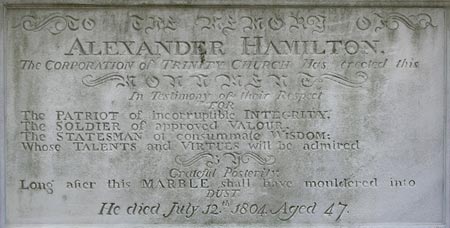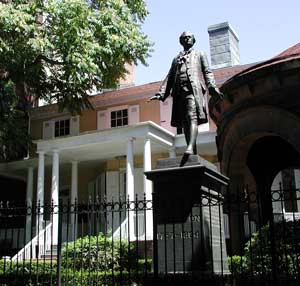
 |
 |
|
|
BACKGROUND | THREE GREAT REPORTS | THE CORPORATE EXAMPLE | THE DUEL
Alexander Hamilton THE DUEL: Alexander Hamilton was one of the most influential of the United States' founding fathers. However, his career was terminated prematurely when he was mortally wounded in a duel with Vice President Aaron Burr. It was the final skirmish of a long political and personal battle between the two men. Hamilton felt that if he did not answer Burr's challenge, he would not be defending his convictions. Hamilton, then 49 years old, met Burr on the morning of July 11, 1804 in Weehawken, New Jersey, where the laws against duels were more lenient than in the State of New York. They rowed across the Hudson River from New York City to a narrow ledge located 20 feet above the water's edge. Hamilton was hit on the first shot and taken to the home of a friend where he died from painful internal bleeding at two o'clock in the afternoon of July 12th. Most duels from this era did not end in death or serious injury. Dueling was considered an honorable contest of wills. However, after this most famous duel in American history, in which a powerful political figure was killed and a vice-president's reputation ruined, dueling became regarded as immoral and destructive. Hamilton left behind him his wife Elizabeth and seven
children. Their oldest child, Peter, died in a duel two years earlier, defending
his father's politics. There had been many accusations that Hamilton had taken
advantage of his own policies for personal profit, but Hamilton was close to
broke when he died. He could have amassed a fortune, but he resolved not to,
preferring instead to leave a respectable public record. Hamilton's last house, "The Grange," stands at 287 Convent Avenue, between 141 st and 142 nd Streets in Harlem, New York City. The National Park Service has plans to restore the house to its original appearance and relocate it 500 feet to the southeast into St. Nicholas Park, where it will be on a larger plot of land. Related Links:
Other Notable Achievements: In 1801, he established the newspaper, the New York Evening Post, which still exists today. He helped his brother-in-law, John Church, to establish the Bank of New York. BACKGROUND | THREE GREAT REPORTS | THE CORPORATE EXAMPLE | THE DUEL |

 Inscription on Hamilton's grave at Trinity Church, on Wall
Street, New York City
Inscription on Hamilton's grave at Trinity Church, on Wall
Street, New York City 